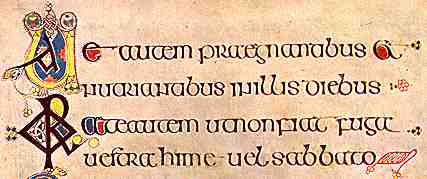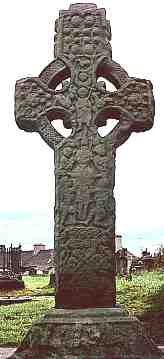 |
| Early
Bibles and Gospels (2) |
| The
12th century traveller and writer, Gerald of Wales, once examined a beautiful
gospel book in
Kildare which he described as the work, not of men, but of angels. His
comments have been traditionally associated with the Book of Kells, but
not for any particularly good reason except that this is the most beautiful
and complete early gospel book surviving from Ireland. The arguments against
the association include that an international sophisticate who had been
to the University of Paris would not have found the figure representations
in the Book of Kells inspiring; that details of his descriptions of the
illustrations are inaccurate; that he got the date of its production wrong;
that he did not mention the history of the manuscript. None of these are
especially convincing. After all, many of Gerald's descriptions are inaccurate,
and who are we to second guess his aesthetic preferences? What does ring
a bell of doubt is that he saw the manuscript in Kildare, which is not
where the Book of Kells resided. Who knows how many exquisite ancient
gospels from Ireland have succumbed to the ravages of time and circumstance? |
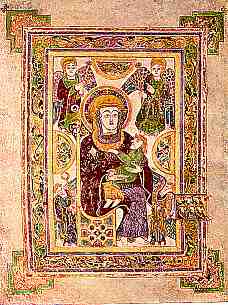 |
|
Full
page miniature of the Virgin and Child, f.7v of the Book of Kells, Trinity
College, Dublin |
| Is
the sample above the work of angels, or crude figural representations
drawn from Classical and Byzantine models? In the Book of Kells, the work
of the angels is in the detail, and in the ethnically Celtic decorative
motifs. |
| The
text of the Book of Kells derives partly from the Vulgate
version of the Bible,
and partly from the Old Latin versions, although the work dates from the
end of the 8th or early 9th centuries. There are some whole passages which
are not included in the Vulgate. The script
is mostly an insular
half uncial, or insular
majuscule, of large, rounded and imposing form. There also are some
examples of pointed insular
minuscule. |
|
| A
segment of text from f.104r, Mark xiii. 17-22, showing the script of the Book
of Kells and a couple of the many decorative initials. This is a section where
the text differs from the Vulgate. |
| There
are doubts about the exact date of the work, and also about where it was produced.
It may have been written on the island of Iona, off western Scotland, or in
Ireland at the monastery of Kells. This may be a significant debate if you
are a Scottish or Irish nationalist, but in historical terms it illustrates
another facet of society entirely. These linked monastic communities formed
their own intellectual and spiritual society which drew from the ethnic roots
of those around them, but made its own connections across cultures. It really
doesn't matter whether it was written in Iona or Kells, because these were
part of one closely intertwined monastic culture. |
|
| An
ancient carved cross at Kells, indicating the significance of the place to
early Christianity in Ireland. |
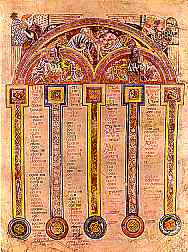 |
Because
these books were service books for use in the liturgy,
they contained some extra material above the simple Biblical text. The
gospels themselves were preceded in the Book of Kells by the Eusebian
canon tables:
a kind of concordance laid out as a table which listed corresponding passages
in the four versions of the gospels. These tables had their own conventions
of representation, under architectural canopies with arches with decorative
canopies. |
|
A
page of the Eusebian canons, f.5r. |
| The
gospel texts are preceded by the breves causae,
or chapter headings, and the argumenta, or
summaries of each of the four gospels. There are some missing leaves,
including the end of the gospel of St John, which also means there is
no colophon to
give some clues about the history of the manuscript. Some blank leaves
after the canon tables have been filled with some charters
in the Irish language relating to the abbey and church of Kells, dating
from around 1024 to the 12th century. It is a known early practice from
the period before the full establishment of written record for property
transactions that such matters be recorded in the spare leaves of a sacred
book. |
|
|
|
|
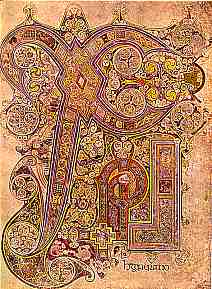 |
It
has occasionally been suggested that this work is so lavish that it was
probably more of a sacred object than a working text, and most likely
not actually used in church. This aspect is emphasised by the story that
it once had a magnificent jewelled cover, like a reliquary. The whole
was stolen in the medieval era, and only the book recovered. It has also
been pointed out that certain passages are contained in decorative pages
that are so elaborate, with complex heading scripts, intricate interlace,
and a puzzle-like arrangement of letters, that the priests could hardly
have been expected to read from it. |
| The so-called Chi-Rho page, the beginning of Matthew i. 18, f.34r. |
| The page reads
XPI b generatio (Christi autem generatio), most of the page being taken
up with the intricately decorated XPI, or chi-rho symbol for Christ. |
| The
decoration, however, has been associated with the important readings for
significant festivals of the church, notably Easter. The Chi-Rho passage
illustrated above represents the first short reading for the mass
on Christmas Eve. This might suggest that the book may have been utilised,
with great ceremony, on some of the most significant occasions of the
church calendar. As for the legibility of the passages, any priest who
did not know these highly significant passages for special occasions by
heart would not have been worthy of the name. |
|
While
the Book of Kells represents the Irish national masterpiece, other less
elaborate, or more fragmentary, early Irish gospels have survived the
centuries. The script and decorative schemes of these works spread far
afield through Northumbria and then south, and across to continental Europe
as Irish and Anglo-Saxon monks set up establishments through France and
Germany to as far afield as Switzerland. |
|
|
A
few lines from the Gospels of MacRegol, of c.800 (Bodleian Library, Auct.
D. 2. 19). |
|
The
above example is a relatively late specimen of the insular half uncial script,
which was replaced for these works with the more compact but still elegant
insular minuscule. |
 |
Segment
from the Book of Armagh, dated 807. |
|
The
Book of Armagh, containing portions of the New
Testament, among other things, was written in a tiny, compressed and
abbreviated, pointed insular minuscule, designed to fit as much text into
a page as possble. This is the earliest dated example of this script,
indicating that the change from large rounded letters to narrow compressed
ones was not a gradual evolutionary process, but the solution to a problem. |
|
next
page  |
 previous page
previous page |
 The Bible
The Bible |
 Categories
of Works Categories
of Works |
|
 |
 |
 |
 |

